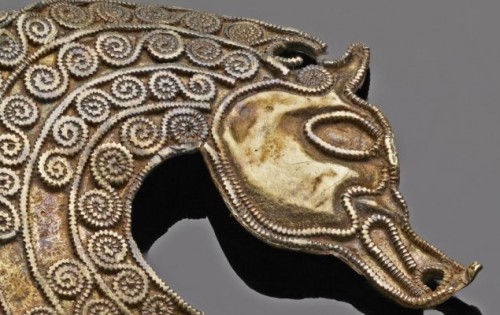archaicwonder:Anglo-Saxon Filigree Seahorse from the Staffordshire Hoard, c. 7th-8th CenturyMany of
archaicwonder:Anglo-Saxon Filigree Seahorse from the Staffordshire Hoard, c. 7th-8th CenturyMany of the pieces in the Staffordshire Hoard are decorated using filigree, a technique which creates patterns by soldering lengths of twisted wire to a base plate. This sea-horse mount is one of the most remarkable pieces in the hoard decorated using this technique. The filigree work on it is astonishingly fine –a grain of rice is longer than three of the spirals which make up the decoration.There is some discussion as to whether this mount really represents a seahorse or not. Some experts argue that the Anglo-Saxons tended not to portray animals particularly realistically and that it is better to regard this mount a showing a stylised horse’s head. Others feel that the shape is so reminiscent of the species of seahorse that lives off the coast of Britain that the maker must really have intended to picture a seahorse.The Staffordshire Hoard is the largest hoard of Anglo-Saxon gold and silver metalwork yet found. Discovered in a field near the village of Hammerwich, near Lichfield, in Staffordshire, England, on 5 July 2009, it consists of over 3,500 items that are nearly all martial in character and contains no objects specific to female uses.The artifacts have tentatively been dated to the 7th or 8th centuries, placing the origin of the items in the time of the Anglo-Saxon kingdom of Mercia. -- source link
#anglo saxon#staffordshire hoard

